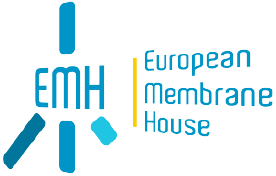The basics of membrane technology
Membrane technology is a physical process for the separation of material mixtures in which a thin layer material a few microns thick functions like a filter. The separated substances are not thermally, chemically or biologically modified. New concepts have emerged in recent years –such as membrane contactors or functionalization – that extend considerably the fields of applications and the interest for membrane technology.
A membrane material is a permeable or semi-permeable thin layer barrier between two phases that restricts the motion of certain components. Phases at both sides of the membrane can be either in liquid or gas form.
Membranes can transport one component from the upstream side phase to the downstream side more readily than any other component or components, and as such induces separation. Porous thin layers are also getting considered as very efficient tools to put into contact different phases. In that case the selectivity of the membrane material is no longer the main focus: this is the concept of “membrane contactor” with applications in separation or reaction. Membrane contactors are used for distillation, extraction, distribution, reaction,…
Membrane materials are classified according to different features: material (organic or inorganic); morphology and structure (symmetric or asymmetric); manufacturing process.
Depending on the manufacturing process, membranes take different forms: tubular, flat or spiral-wound membranes. The membranes are placed in an engineered unit, the module. The module is of decisive importance for the membranes to be efficient. There are a large number of different module constructions to meet the requirements of end users.
Membrane processes are many. They vary in molecular separation size and in the driving force expended:
Microfiltration
Microfiltration (MF) closely resembles conventional coarse filtration and deals with the separation of particles between 0.1 and 10µm, such as suspended solids (colloids), bacteria and large proteins. MF is applied for clarification and sterilization purposes, for cell harvesting, separation of oil-water emulsions, etc.
Ultrafiltration
Ultrafiltration (UF) belongs to the pressure-driven membrane processes. This technique uses microporous membranes with 1-100 nm pore diameters. Such membranes let through small molecules (water, salts) and adopt the high molecular weight molecules (polymers, proteins, colloids). Operating pressures are typically in the range of 1 to 5 bars for cross-flow application. UF is ideally suited for fractionation, concentration and purification purposes.
Reverse Osmosis
Reverse Osmosis (RO) is used to separate components of a solution. It is based on a pressure-driven process, the driving force resulting from the difference of the electrochemical potential on both sides of the membrane. Operating pressures can range from 10 bars up to 100 bars. A typical RO application is seawater desalination.
Nanofiltration
Nanofiltration (NF) is a pressure-driven membrane process which is preferentially used for the recycling of aqueous solutions. Operating pressures are between 5 and 20 bars.
Electrodialysis
Electrodialysis (ED) is a membrane process, during which ions are transported through semi permeable membrane, under the influence of an electric potential. The membranes are cation or anion-selective, which basically means that either positive ions or negative ions will flow through. ED is used for desalination, demineralisation and the removal of metals.
Pervaporation
Pervaporation (PV) is a fractionation process in which a liquid mixture is maintained at atmospheric pressure on the feed side of the membrane, while the permeate is removed as a vapor. Transport is induced by using a vacuum pump at the permeate side or by cooling the permeate vapor to create a partial vacuum.
Gas separation membranes are applied on an industrial scale in several areas: air separation, hydrogen separation and recovery, natural gas separations, air dehydration, organic vapor recovery, and reduction or elimination of CO2 emissions from electricity power plants fuelled by coal or gas.
Major developments are expected in the area of membrane functionalisation, e.g. by modification with ligands, by a combination with enzymes and/or nanoparticles.


